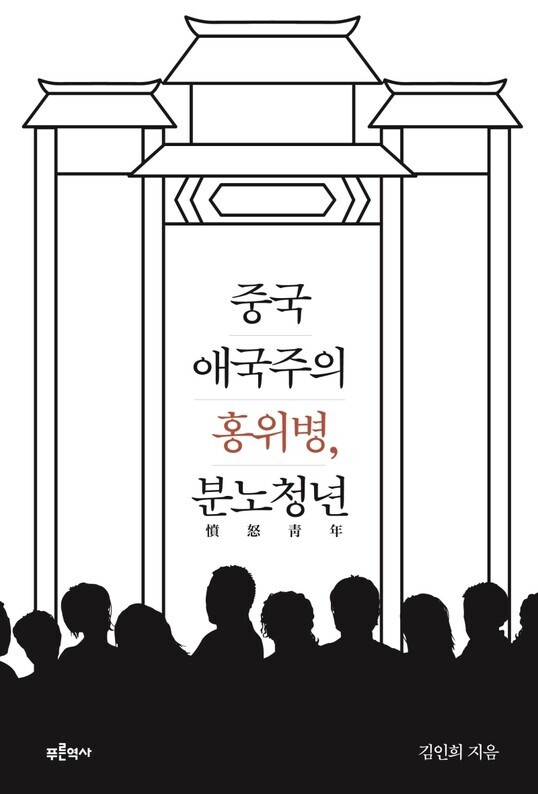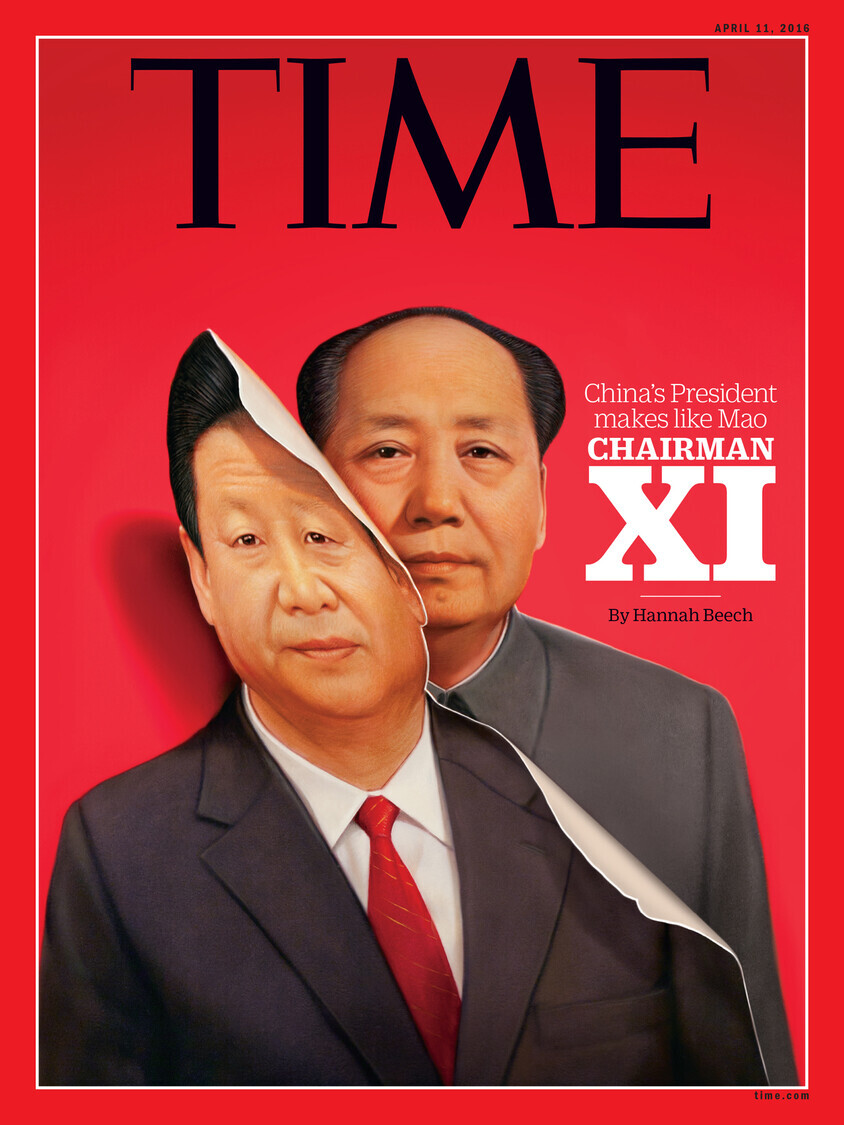hankyoreh
Links to other country sites 다른 나라 사이트 링크
[Book review] Is Xi Jinping dreaming of launching his own cultural revolution?

This book, written by Kim In-hui, introduced me to the Chinese expression “guanshuifa” — literally, “the method of pouring water,” but implying ideological brainwashing in education. This book specifically refers to the patriotic education with which Chinese students are indoctrinated, an education that fills their heads with imperial aggression, the heroic struggle of the Communist Party, and hatred for the US and Japan.
The “water” poured into these students’ heads consists of Han Chinese nationalism, socialism, and statism. This patriotic brainwashing has produced China’s irrational “angry youth” (fennu qingnian, often abbreviated as fenqing). These are urban youth with too much free time who express unbridled rage on the Internet.
But it goes further than that. There has recently been increasing activity by the “little pinks” (xiao fenhong) with the effective support of the Chinese government and the Chinese Communist Party (CCP). The character “hong,” meaning “red,” symbolizes love for the party, the state, and the leader.
Kim explains how the little pinks are different from the angry youth: “They’re the people who were born after 1990, who have been totally brainwashed with patriotic education from their birth. That sets them apart from the angry youth, whose patriotic education began in elementary school or middle school. More than 73% of the little pinks are university graduates, and what’s particularly notable is that more than 37% of them have a graduate degree.”
Chinese history education “is composed of the greatness of ancient history, hatred of the modern invaders, and loyalty to the CCP,” wrote Kim, who is well-informed about China’s policy on history and ethnic groups.
China’s history education has “planted the seeds of hatred in the minds of students” with the goal of creating 21st century “red guards” who are loyal to the Communist Party. This history education produces tendencies and attitudes that are irrational, radical, and even violent toward foreign countries.
An outline for patriotic education in the new era published on Nov. 12, 2019, by the CCP Central Committee and China’s State Council appears as an appendix at the end of the book. This outline begins as follows: “Patriotism is the heart and soul of the Han Chinese nation and a powerful spiritual drive for protecting the dignity and independence of the Chinese people and the Chinese nation. The spirit of patriotism is deeply rooted in the hearts of the Chinese nation and encourages China’s sons and daughters to continually strive and fight for the development and prosperity of the fatherland down through the generations.”
Kim writes that the country the angry youth badmouth the most (other than Japan) is South Korea. These young people attack Korea for stealing Chinese culture, asserting that kimchi and hanbok (Korea’s traditional attire) originated in China.
“They think that they can take out their rage on Korea, which they see as being too small and weak to do anything about it,” Kim writes.
What follows is an excerpt from a typical angry youth post titled “Korea, land of plastic surgery and voyeurism.”
“Korea is the hypocritical half of a small peninsula that tricks the world by stealing other people’s glory. Korean culture is a hodgepodge of foreign influences, centered on Chinese Confucianism, with elements from Japan and the US added later. Koreans steal from China as they try to pose as having a great and brilliant civilization. Empress Myeongseong, whom Koreans adore as a national hero, was the concubine of Yuan Shikai; she was raped and murdered by Japanese thugs and her naked body was burned to ashes.”
The angry youth are the new red guardsKim locates the historical background of today’s angry youth in the red guards and the Cultural Revolution, in the era of Mao Zedong. Both the red guards and the angry youth are groups of young people who were educated to have a particular mindset. They were educated in political socialization and patriotism, respectively, and equipped with the ideological weapons of socialism and patriotism. While there’s a difference between their targets (the propertied class for the red guards and foreigners for angry youth), they’re both directed by the ideology in which they were educated to seek out, track, and attack those targets.
The author argues that the ideological weapon tying the two groups together is Sinocentrism, the belief that China ought to be the center of the world. This belief reflects intense hostility to foreign powers.
Another commonality between the red guards and angry youth is that they’re both politically exploited by the nation’s leaders. Kim notes that the patriotic education received by the angry youth is a “21st century version of political socialization that merely substitutes foreign countries for the propertied class as the subject of attack.”
Liberal intellectuals sharply criticized the angry youth online, but they’ve faced government sanctions over the past decade and have basically disappeared.
Kim draws attention to the possibility that Chinese President Xi Jinping will launch another cultural revolution in order to create the political conditions for becoming a permanent dictator.

There are numerous signs that Xi is doing exactly that. In March 2018, the National People’s Congress revised China’s constitution to eliminate term limits on the president. Xi also became the first Chinese leader since Mao Zedong to receive the reverential title “lingxiu.”
Just like Mao Zedong thought, Xi Jinping thought has now been written into the state constitution as one of the state’s leading ideologies. And just like the “Little Red Book” containing Mao Zedong’s quotations, Xi’s quotations and thoughts appear in the app “Xuexi Qiangguo,” developed in 2019.
In 2010, Li Zehou, one of China’s leading philosophers, spoke of the danger of combining populism with the nationalistic belief that the “Chinese dragon” controls the world. That combination, Li said, could make China belligerent overseas and tyrannical at home. Li added that China was courting danger in its pursuit of state socialism, a danger inherent in the very “Chinese model” that China was flaunting.
Kim’s book presents the historical backdrop and a vivid panorama of the phenomena of patriotism and the angry youth in 21st century China, paralleling the red guards mentioned in the title. The reportage here is much truer to life than the reports occasionally seen in the press.
After reading this book, some will find themselves angry at China, others will reflect upon the fact that this is the China we have to deal with, and still others will wonder if the situation is really as bad as Kim makes it out to be.
Various predictions are made about the future of China. Some think China will grow even more authoritarian and hegemonic, while others expect that the regime will gradually grow more flexible, while maintaining its basic character.
Kim offers this warning at the end of the book: “China’s patriotic education will gradually intensify, and in the end, even more people will be exposed to a greater risk of the ‘banality of evil.’”
Upon completing the book, I kept coming back to the question that Kim poses in the introduction: “Which kind of country have Koreans assumed China to be?”
By Pyo Jung-hoon, book columnist
Please direct comments or questions to [english@hani.co.kr]

Editorial・opinion
![[Column] Season 2 of special prosecutor probe may be coming to Korea soon [Column] Season 2 of special prosecutor probe may be coming to Korea soon](https://flexible.img.hani.co.kr/flexible/normal/500/300/imgdb/original/2024/0426/3317141030699447.jpg) [Column] Season 2 of special prosecutor probe may be coming to Korea soon
[Column] Season 2 of special prosecutor probe may be coming to Korea soon![[Column] Park Geun-hye déjà vu in Yoon Suk-yeol [Column] Park Geun-hye déjà vu in Yoon Suk-yeol](https://flexible.img.hani.co.kr/flexible/normal/500/300/imgdb/original/2024/0424/651713945113788.jpg) [Column] Park Geun-hye déjà vu in Yoon Suk-yeol
[Column] Park Geun-hye déjà vu in Yoon Suk-yeol- [Editorial] New weight of N. Korea’s nuclear threats makes dialogue all the more urgent
- [Guest essay] The real reason Korea’s new right wants to dub Rhee a founding father
- [Column] ‘Choson’: Is it time we start referring to N. Korea in its own terms?
- [Editorial] Japan’s rewriting of history with Korea has gone too far
- [Column] The president’s questionable capacity for dialogue
- [Column] Are chaebol firms just pizza pies for families to divvy up as they please?
- [Column] Has Korea, too, crossed the Rubicon on China?
- [Correspondent’s column] In Japan’s alliance with US, echoes of its past alliances with UK
Most viewed articles
- 1After election rout, Yoon’s left with 3 choices for dealing with the opposition
- 2Why Kim Jong-un is scrapping the term ‘Day of the Sun’ and toning down fanfare for predecessors
- 3Two factors that’ll decide if Korea’s economy keeps on its upward trend
- 4Noting shared ‘values,’ Korea hints at passport-free travel with Japan
- 5AI is catching up with humans at a ‘shocking’ rate
- 646% of cases of violence against women in Korea perpetrated by intimate partner, study finds
- 7Why Korea shouldn’t welcome Japan’s newly beefed up defense cooperation with US
- 8‘We must say no’: Seoul defense chief on Korean, USFK involvement in hypothetical Taiwan crisis
- 9[Column] Season 2 of special prosecutor probe may be coming to Korea soon
- 10Fast Food Workers’ Day comes to South Korea